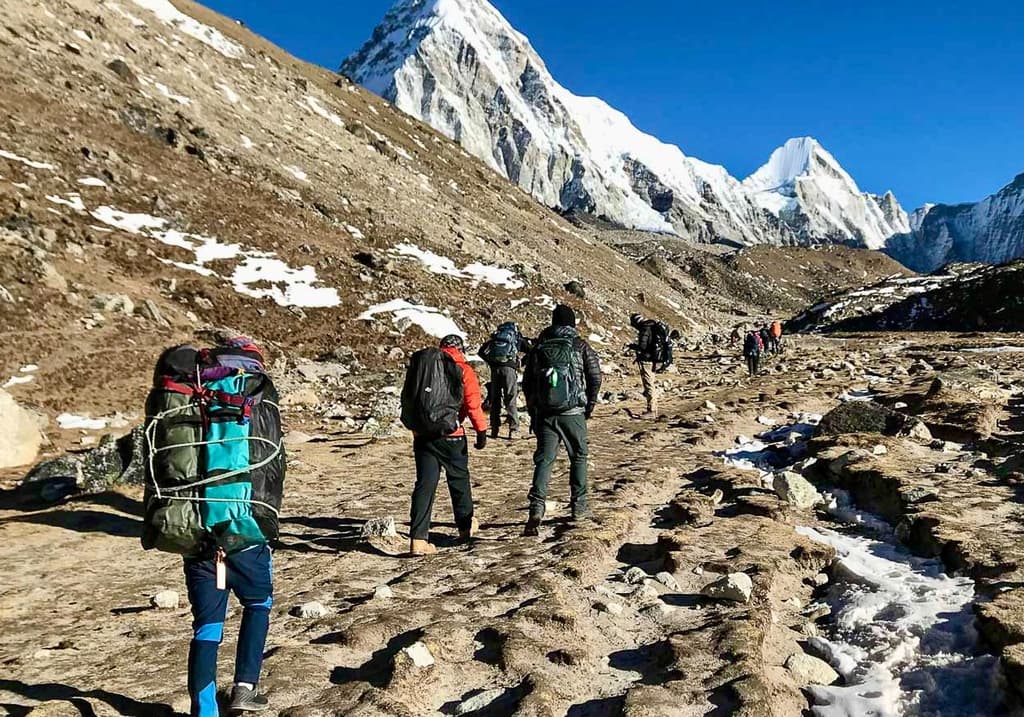Is it safe to trek to Everest Base Camp? It's a question many aspiring trekkers ponder upon. Understandably, the sheer thought of venturing into the world's highest mountain range can be daunting. But, the answer is "Yes," it is safe to trek to Everest Base Camp, provided you follow the right protocols, make thoughtful preparations, and respect the mountains.
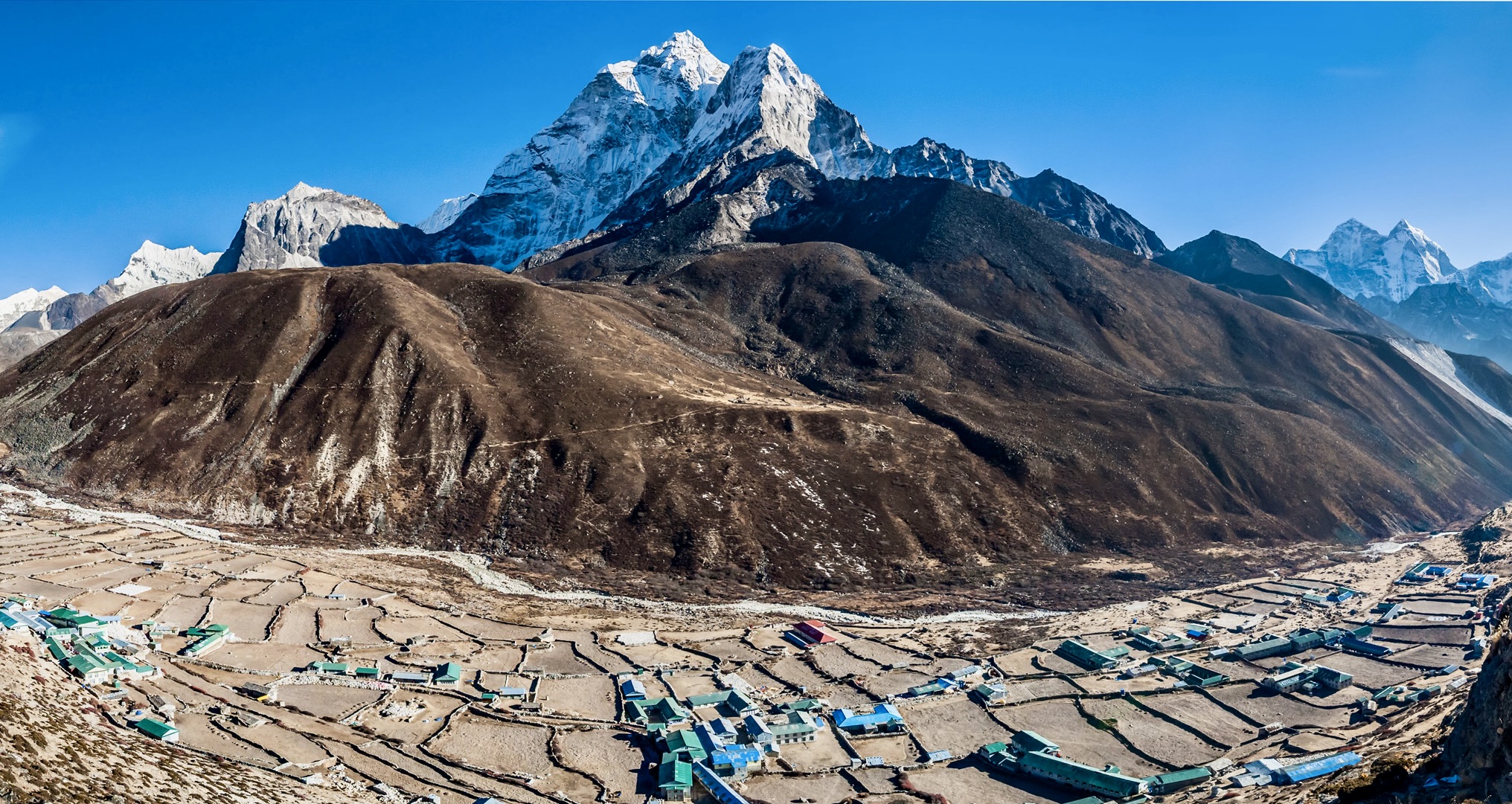
Safety on the trail to Everest Base Camp is contingent on several factors such as the timing of the trek, weather conditions, physical fitness, acclimatization, and importantly, the guidance of experienced trekking guides. This blog post aims to address these crucial aspects to assure you that with the right planning and precautions, the Everest Base Camp trek can be a safe and life-enriching experience. Let's delve into these factors and see how you can navigate them to make your trekking journey a safe one.
Preparing for the Everest Base Camp Trek: Ensuring Safety from the Start
As with any adventure, safety begins with ample preparation, and the Everest Base Camp Trek is no exception. This trek is a challenging endeavor that demands a decent level of fitness, mental stamina, and, preferably, some experience in high-altitude trekking. Here are some key aspects to consider while preparing for this journey:
Physical Fitness
The Everest Base Camp Trek is physically demanding, involving daily walks for multiple hours over hilly terrain, with a backpack on. Therefore, getting in good physical shape is crucial to ensure a safe and enjoyable trek. Starting a fitness regimen several months before the trek is recommended. This should ideally include a mix of cardio workouts (such as running, cycling, or swimming), strength training (particularly focusing on the legs and core), and flexibility exercises.
Trekking Experience
While the Everest Base Camp Trek doesn't necessitate technical mountaineering skills, prior experience in long-distance hiking or trekking can certainly enhance your safety and comfort. Experience helps in understanding your body's response to sustained physical activity and high altitude, enabling you to pace yourself better during the trek.
Altitude Training
One of the significant challenges of the Everest Base Camp Trek is dealing with altitude. The trek takes you up to a height of over 5,500 meters, where the oxygen level is significantly lower than at sea level. To prepare for this, consider doing some high-altitude training if possible. This might include hiking in high-altitude areas, using an altitude training mask, or training at an altitude center.
Nutrition and Hydration
Proper nutrition and hydration play a vital role in maintaining your energy levels during the trek. In the months leading up to the trek, maintain a balanced diet rich in protein for muscle repair and complex carbohydrates for sustained energy release. Also, practice drinking plenty of water during your training hikes as maintaining hydration is crucial at high altitudes.
Health Check-up
Before undertaking the Everest Base Camp Trek, it's advisable to get a thorough medical check-up. The trek can be strenuous and taxing, especially for individuals with pre-existing medical conditions like heart disease, lung disease, or high blood pressure. A medical check-up can help assess whether you're fit for the trek and identify any health issues that need management.
Mental Preparation
Finally, mental preparation is just as crucial as physical preparation. The trek involves long days of strenuous hiking, often in harsh weather, and mental resilience can make the difference between a successful and enjoyable trek versus a challenging and unsafe one.
Good preparation is key to a safe Everest Base Camp Trek. Start your preparations months in advance, focus on your physical fitness and mental resilience, and always listen to your body during the trek. Remember, the journey is as important as the destination.
Importance of Experienced Guides and Porters for a Safe Everest Base Camp Trek
When it comes to ensuring safety on an Everest Base Camp Trek, the importance of an experienced guide and porter cannot be overstated. Not only do they provide essential logistical support, but their knowledge and experience can also prove crucial in ensuring a safe and enjoyable trek.
Guides: Your Mountain Gurus
Experienced guides are well-versed in the trail's nuances, knowing what to expect, and understanding how to react in various situations. Their knowledge of the terrain and weather patterns can help avert potential dangers. Additionally, they are trained in first aid and high-altitude sickness management, skills that could prove life-saving in emergencies.
Local guides also offer invaluable insights into the region's culture, history, and biodiversity, enriching your trekking experience. They will advise you on proper acclimatization strategies and ensure that you maintain a safe and sustainable pace throughout the journey.
Porters: Your Essential Support
Porters are an integral part of the trekking experience, as they transport most of your heavy gear, allowing you to focus on the trek itself. By carrying the bulk of your load, porters help conserve your energy and reduce the risk of fatigue-related injuries. It's essential to ensure that your porter is also adequately equipped and not overburdened, as their safety is equally important.
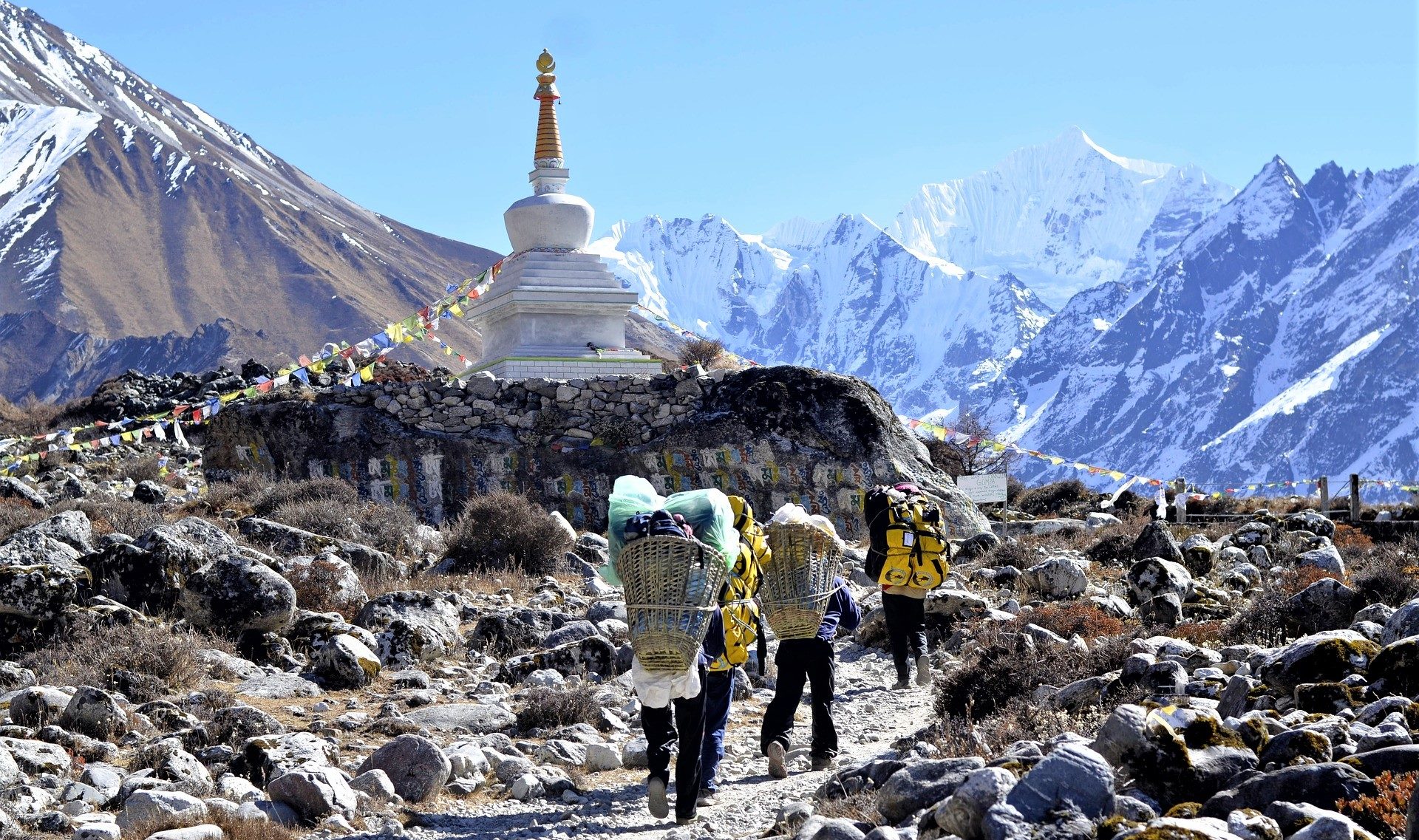
Hiring Guides and Porters
When hiring guides and porters, consider their experience, knowledge of English (or a language you're comfortable in), and training in first aid and altitude sickness. It's also essential to ensure they have the necessary insurance coverage. Reputable trekking agencies like Luxury Holidays Nepal ensure that their guides and porters meet these criteria, so you can focus on enjoying the trek.
In conclusion, an experienced guide and porter are invaluable assets on an Everest Base Camp Trek. Not only do they help ensure your physical well-being, but they also enhance your overall trekking experience. While it's an additional cost, the benefits they provide in terms of safety and support far outweigh the expense.
Dealing with Altitude Sickness: An Essential Part of Ensuring Safety on the Everest Base Camp Trek
Altitude sickness, also known as Acute Mountain Sickness (AMS), is one of the significant challenges and potential dangers trekkers face while attempting the Everest Base Camp (EBC) trek. Understanding what altitude sickness is, recognizing its symptoms, and knowing how to prevent and treat it is essential for a safe and successful trek.
What is Altitude Sickness?
Altitude sickness is a condition that can occur when one ascends to high altitudes too quickly, typically above 2,500 meters (8,000 feet). The decrease in atmospheric pressure at higher altitudes leads to lower oxygen levels in the air, making breathing more challenging and causing the symptoms of altitude sickness.
Recognizing the Symptoms
The common symptoms of altitude sickness include headache, dizziness, nausea, difficulty sleeping, shortness of breath, and loss of appetite. These symptoms usually appear within a few hours after reaching a high altitude. It's essential to communicate any discomfort to your guide immediately, as early detection and treatment can prevent the condition from becoming severe or life-threatening.
Preventing and Treating Altitude Sickness
The key to preventing altitude sickness is acclimatization – allowing your body time to adjust to the lower oxygen levels at high altitudes. This is achieved by following the "climb high, sleep low" principle, which involves ascending slowly, taking frequent rest days, and sleeping at a lower altitude than the highest point reached during the day.
Staying well-hydrated, avoiding alcohol, eating a high-carb diet, and getting plenty of rest can also help prevent altitude sickness. Medications such as Diamox (Acetazolamide) can be used under medical supervision to prevent and treat AMS.
In severe cases, the best treatment for altitude sickness is to descend to a lower altitude as quickly and safely as possible. Oxygen and portable altitude chambers can provide temporary relief, but they are not substitutes for descending.
While altitude sickness is a risk factor for the Everest Base Camp trek, it can be effectively managed through proper acclimatization and immediate response to symptoms. Trekking with a knowledgeable guide who can recognize and address the early signs of altitude sickness can ensure your safety on the trail. Remember, "slow and steady" not only wins the race but also ensures a safe and enjoyable trekking experience.
Is Your Trek to Everest Base Camp Covered? The Importance of Travel Insurance
Trekking to Everest Base Camp is an adventure of a lifetime, but it also comes with certain risks. Thus, having suitable travel insurance coverage is an essential safety measure. A comprehensive travel insurance policy can offer financial protection against unforeseen situations such as accidents, illnesses, and emergencies that may occur during your trek.
Why Do You Need Travel Insurance?
While the Everest Base Camp trek is generally safe with the right preparation and a competent guide, unexpected incidents can happen. These can range from minor inconveniences like lost luggage or delayed flights to major emergencies such as acute mountain sickness (AMS), injuries, or natural disasters.
In such cases, the cost of emergency evacuation – especially helicopter evacuation – can be exorbitantly high. Having travel insurance ensures that you can receive prompt medical attention without worrying about the cost.
What Should Your Travel Insurance Cover?
An ideal travel insurance policy for the Everest Base Camp trek should cover the following:
- Emergency Evacuation and Repatriation: In case of severe illness or injury, your insurance should cover the cost of an emergency evacuation, which can be by helicopter from remote areas. It should also cover repatriation, which is the return to your home country for further treatment.
- Altitude Coverage: Not all insurance policies cover trekking at high altitudes. The Everest Base Camp is over 5,000 meters above sea level, so make sure your policy covers you up to this altitude.
- Trip Cancellation and Interruption: If you have to cancel or cut short your trip due to unforeseen circumstances, your insurance should reimburse the costs.
- Medical Expenses: The policy should cover hospital charges, medication costs, and fees for medical practitioners.
- Loss or Delay of Baggage and Personal Belongings: If your baggage is lost or delayed, your policy should cover the cost of replacing essential items.
- Travel Delays and Disruptions: If your flight is delayed or canceled, causing you to miss a connecting flight or disrupting your trek schedule, your policy should cover the additional accommodation and travel costs.
Remember, the cheapest policy might not always offer the best coverage. Always read the fine print to ensure that you understand what is and isn't covered.
While we hope never to use it, having travel insurance can provide peace of mind during your Everest Base Camp trek. It's a small investment towards ensuring your safety and financial protection in the face of unpredictability. Trek smart, trek safe!
Ensuring Your Well-being: Accommodation and Food Hygiene During the Everest Base Camp Trek
One key concern many trekkers have when undertaking the Everest Base Camp (EBC) Trek is regarding accommodation and food hygiene. While it's natural to have these concerns, let us reassure you that the teahouses and eateries along the trail prioritize the well-being of their guests and work diligently to ensure clean and safe conditions.
Accommodation Hygiene on the EBC Trek
The primary form of accommodation along the EBC trek is teahouses, which are small, locally-run lodges offering basic amenities. While you shouldn't expect luxury, these teahouses provide clean bedding and shared or private toilet facilities. They are typically heated in the common areas but expect colder conditions in your sleeping quarters. It's a good idea to bring a good-quality sleeping bag to stay warm during the chilly nights.
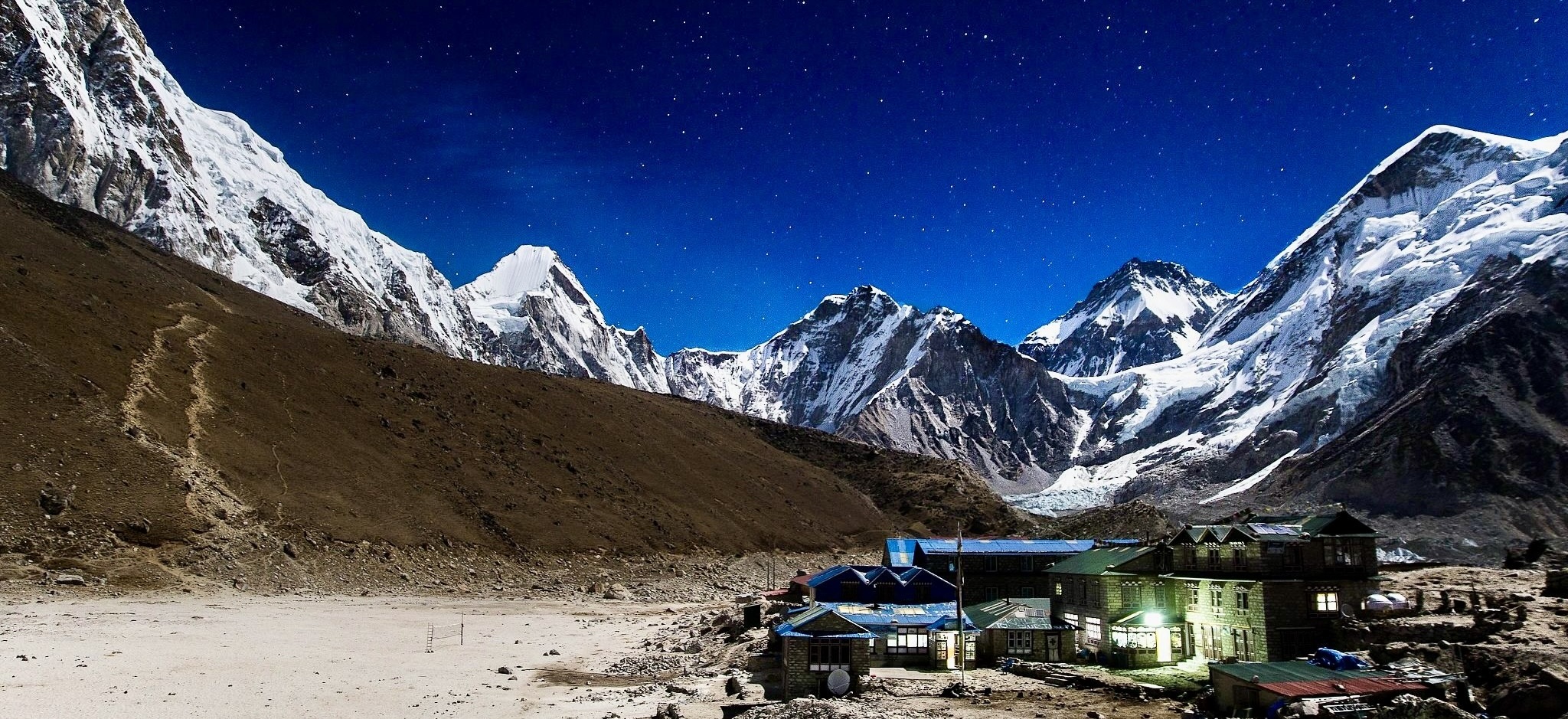
Hygiene practices have improved significantly over the years. The teahouses understand the importance of cleanliness and make efforts to provide clean and comfortable accommodations for trekkers. However, as it is a remote area, standards may not be equivalent to those in urban areas.
Food Hygiene on the EBC Trek
Food hygiene is a vital part of maintaining health during the trek. The teahouses along the trail serve a variety of meals, including traditional Nepalese food, as well as some Western dishes. The most popular meal is 'Dal Bhat', a traditional Nepalese dish comprising lentil soup, rice, and curried vegetables.
The food prepared in the teahouses is generally safe to eat. They understand the significance of serving hygienically prepared food to trekkers to avoid any food-borne illness. However, here are a few tips to help avoid any potential issues:
- Stay Hydrated: Drink plenty of treated water. Avoid tap water, and either opt for bottled water or treat the water with purification tablets.
- Go Vegetarian: Opt for vegetarian meals. Meat items are often carried up by porters and may not be fresh. Vegetarian dishes, on the other hand, are safer as the ingredients are locally sourced and freshly prepared.
- Avoid Uncooked Food: Stick to hot, cooked meals and avoid uncooked meals like salads, as raw food might be washed with untreated water.
- Hot Drinks: Opt for hot drinks like tea or coffee. The boiling process kills any potential pathogens, making these safer to drink.
- Hand Sanitizer: Use hand sanitizer before meals to ensure your hands are clean.
With a little caution and awareness, you can maintain hygiene during your EBC trek. The trail to Everest Base Camp is well-traveled, and the teahouses are experienced in catering to international trekkers. So, rest assured, the trek to Everest Base Camp can be a safe and unforgettable experience.
Trekking Safely: The Importance of Proper Gear on the Everest Base Camp Trek
The Everest Base Camp Trek is an adventurous journey that takes you into the heart of the Nepalese Himalayas, showcasing some of the world's most spectacular scenery. However, as with any high-altitude trek, it does come with certain risks. Ensuring you have the proper gear can go a long way towards mitigating these risks, and will significantly enhance your safety and comfort on the trail.
Here are some essential items that you'll need for a safe and successful trek:
- Trekking Boots: A good pair of trekking boots is crucial. They should be waterproof, well-insulated, and broken in before you embark on your trek. Poorly fitting or unsuitable boots can cause blisters and discomfort, which could significantly impact your trekking experience.
- Layers and Warm Clothing: The temperature can vary greatly throughout the day and from day to day on the trek. Layering your clothing will allow you to adjust to these changing temperatures. Remember to pack thermal underwear, fleece jackets, and down jackets for the cold evenings and mornings. A good-quality, waterproof, and windproof jacket is also crucial for protecting against potential severe weather conditions.
- Sunglasses and Sunscreen: At high altitudes, the sun's rays can be extremely powerful. High-quality sunglasses with UV protection are essential to protect your eyes from intense sunlight and reflective snow. A high-SPF sunscreen will also protect your skin from harmful UV rays.
- Trekking Poles: Trekking poles can provide stability and support, particularly on steep, uneven terrain and during river crossings. They can also reduce the impact on your knees and legs, particularly during descents.
- Headlamp: There will be times, especially if you are starting your day early for a sunrise view or finishing late when a headlamp will be vital. Always have one in your pack, even if you don't plan to use it.
- First Aid Kit and Medications: Carry a basic first aid kit including band-aids, antiseptic cream, and bandages. It's also wise to carry any necessary personal medications, as well as treatments for common trekking ailments like diarrhea, altitude sickness, and colds.
- Hydration and Snacks: Staying hydrated and maintaining your energy levels is crucial. Carry a refillable water bottle or hydration bladder and remember to drink frequently. Energy-dense snacks like nuts, dried fruit, and energy bars can also provide a valuable energy boost.
Having the right gear can make a huge difference to your trekking experience. It's one of the key aspects of safety and comfort on the trek. Always remember to check and double-check your gear list before you start your trek to Everest Base Camp.
Selecting the Best Time
Choosing the right time to embark on your Everest Base Camp trek can significantly impact the safety and success of your journey. The most popular times for this trek are during the pre-monsoon (spring) and post-monsoon (autumn) periods, when the weather is generally clear and dry.
Spring (March to May): The spring season is one of the best times to trek to Everest Base Camp. The weather is relatively mild during this time, with daytime temperatures at lower altitudes ranging from 10°C to 15°C. Higher up, temperatures can drop below freezing, particularly at night. However, the trails are generally dry, and visibility is good. The spring season also sees the blooming of rhododendrons, making for picturesque landscapes.
Autumn (September to November): Autumn is another prime season for trekking in the Everest region. Monsoon rains have cleared the dust from the air, resulting in spectacular mountain views. Temperatures are similar to those in spring, and the weather is generally stable, with less chance of flights into Lukla being canceled due to poor visibility.
The monsoon season (June to August) is less popular for trekking due to heavy rains, which can make the trails slippery and challenging. Also, flights can often be delayed or cancelled due to poor visibility.
Winter (December to February) is also a less popular time to trek due to the cold temperatures and the potential for heavy snowfall. However, the trails are less crowded during this time, and on clear days, the mountain views are exceptional.
Regardless of when you choose to trek, mountain weather can be unpredictable, and conditions can change rapidly. It's essential to be prepared for a range of conditions and to listen to the advice of your guide. They are experienced in reading the conditions and making decisions to ensure your safety.
Horses for Hire on Everest
Trekking to Everest Base Camp is undoubtedly a challenging adventure. While it offers an unparalleled opportunity to immerse yourself in spectacular landscapes, it also demands physical exertion and endurance. For those who might need a bit of assistance along the way, horses and ponies are available for hire in certain sections of the trek.
When Are Horses Used?
Horses are commonly used in the lower altitude regions of the Everest trek, where the terrain is less rugged. They are typically used to transport goods and supplies between villages but are also available to help trekkers who may be struggling with fatigue, injury, or altitude sickness.
It's important to note, however, that using horses is not an option for the entirety of the trek. The higher regions of the trail, above Dingboche or Lobuche, are typically too steep and rocky for horses. For these sections, trekkers must rely on their own strength and endurance.
How to Hire a Horse?
Your trekking guide can arrange the hire of a horse if it becomes necessary. The cost of hiring a horse can vary depending on the distance you plan to cover and the current demand.
Things to Consider
While hiring a horse can ease the physical challenge of the trek, it's essential to remember that riding a horse at high altitudes still requires a certain level of physical fitness and endurance. Also, the ride can be quite bumpy and uncomfortable, particularly over rocky terrains.
Finally, it's important to ensure that the horses are well cared for and not overworked. Reputable trekking companies or guides will only work with responsible horse owners who take good care of their animals.
While horses can be hired for parts of the Everest Base Camp Trek, they should be considered a backup option for those struggling with the trek rather than the primary means of completing the trek. The best way to prepare for the trek is through physical training, adequate acclimatization, and taking care of your health throughout the journey.
Train for the Everest Base Camp Trek
Trekking to Everest Base Camp is a physically demanding adventure that requires a high level of fitness. To enjoy the experience and to enhance your chances of reaching Base Camp, it's important to prepare your body adequately in the months leading up to the trek. Here's how you can train for the Everest Base Camp Trek.
Start Early and Gradually Increase Your Training Intensity
You should ideally begin your training at least 12 weeks before your trek. Start with a baseline level of fitness and gradually increase the intensity of your workouts over time. It's important to allow your body time to adapt to the physical stress, so avoid making sudden, drastic changes in your training routine.
Cardiovascular Training
Cardio workouts should form the bulk of your training. Running, cycling, swimming, and hill climbing are excellent activities for building stamina and improving your cardiovascular fitness. Aim to do at least 3-4 sessions of cardio per week, with each session lasting about 30-60 minutes.
Strength Training
While the trek isn't overly technical, it will involve long days of walking, often with a backpack. Therefore, strengthening your core, legs, and back muscles is crucial. Include two to three strength training sessions per week in your workout routine. Exercises such as squats, lunges, and planks are particularly beneficial.
Altitude Training
Preparing your body for high altitude is a key aspect of training for the Everest Base Camp Trek. If you live near mountains, try to do regular hikes at altitude. If not, using a stair climber or doing hill repeats can simulate the ascent. It's also beneficial to practice deep breathing exercises to improve your lung capacity.
Flexibility and Balance
Yoga and stretching exercises are valuable for improving flexibility and balance, which can help prevent injuries on the trek. Try to incorporate a few sessions into your weekly routine.
Mental Preparation
Finally, remember that mental stamina is just as important as physical fitness. The trek can be challenging, but with the right mindset, you can overcome any obstacles that come your way.
Preparing for the Everest Base Camp Trek involves a combination of cardiovascular training, strength workouts, altitude preparation, and mental conditioning. By starting early and progressing gradually, you can reach a level of fitness that will help you enjoy the trek to its fullest.
Trek with the Experts
While you can certainly trek to Everest Base Camp independently, trekking with experts significantly enhances your safety. Professional trekking companies have years of experience navigating the route and dealing with unpredictable weather and altitude changes.
Here's why you should consider trekking with experts:
Expert Guidance
Experienced guides know the trails like the back of their hand. They can choose the safest and most scenic paths, and they know how to avoid potential hazards. They are also trained to monitor your health and well-being and can recognize early signs of altitude sickness, which is vital in high-altitude environments.
Support Staff
A professional trekking team includes porters who will carry your heavy gear. This allows you to focus on the trail and the beautiful surroundings instead of exhausting yourself with a heavy load. This greatly reduces the risk of injury and exhaustion.
Logistics and Planning
Trekking companies take care of all the logistics like permits, accommodation, meals, and transportation, ensuring you have a safe and comfortable trek. This allows you to focus solely on the trek and enjoy the experience without worrying about the details.
Emergency Support
In case of an emergency, professional trekking companies have the resources and contacts to arrange immediate assistance or evacuation. They are equipped with first-aid supplies and, often, with oxygen cylinders and altitude sickness medication.
Knowledge of Local Culture
Guides not only lead you through the trails but also introduce you to the local culture, traditions, and history of the region, enhancing your overall trekking experience.
Trekking to Everest Base Camp is an adventure of a lifetime, and trekking with experts can ensure you have a safe, well-managed, and unforgettable experience.
Is Everest Base Camp Trek Dangerous?
Trekking to Everest Base Camp is a high-altitude adventure that comes with its share of risks and challenges. However, calling it 'dangerous' might give the wrong impression. While it's true that there are inherent risks associated with trekking at such high altitudes - including Acute Mountain Sickness (AMS), harsh weather conditions, and challenging terrains - these risks can be managed effectively with proper preparation, guidance, and caution.
Here are the main challenges and how they can be mitigated:
Acute Mountain Sickness (AMS): AMS is a potential risk for anyone trekking above 2,500 meters. It's caused by gaining altitude too quickly and not giving your body time to adjust to the decreased oxygen levels. The key to preventing AMS is acclimatization. Take your time to ascend, rest, hydrate, and listen to your body. Trekking companies often build acclimatization days into their itineraries.
Harsh Weather Conditions: Weather in the Everest region can be unpredictable, with sudden temperature drops and snowfall, especially at higher altitudes. Checking weather forecasts, packing appropriate clothing, and following professional advice can help you manage weather-related risks.
Challenging Terrains: The trails to Everest Base Camp include steep ascents, rocky paths, and suspension bridges, which can be tough for some trekkers. Prior physical conditioning, taking it slow, and using trekking poles can make traversing these terrains safer and easier.
Other Health Risks: Dehydration, sunburn, and hypothermia are other potential risks. These can be mitigated by drinking plenty of water, using high-factor sunscreen, wearing sunglasses, and dressing in layers.
Travel with a Guide: Travelling with a knowledgeable guide can dramatically reduce the risks. They can help you with acclimatization, choose the safest paths, monitor your health, and manage emergencies.
While there are risks involved in the Everest Base Camp Trek, they can be managed effectively with the right preparation and precautions. Hundreds of trekkers safely complete the trek each year. The most important thing is to respect the mountain, listen to your body, and never push beyond your comfort zone. With that approach, the trek is more adventurous than dangerous.
Safety Notes for Everest Base Camp Trek
Everest Base Camp trek is an adventure, but it is essential to remember that safety should always be the top priority. Here are some safety notes that every trekker should consider for a successful journey:
- Choose the Right Time for Trekking: The best times to trek to Everest Base Camp are pre-monsoon (March to May) and post-monsoon (late September to November). These periods typically offer the best weather conditions, and clear visibility, and are relatively safer.
- Hire a Professional Guide and Porter: A professional guide knows the trails, speaks the local language, and is trained in first aid and altitude sickness response. They will also be able to guide you to safer routes and give valuable advice about the trek.
- Prioritize Acclimatization: Ascending too quickly is a common cause of altitude sickness. Ensure you follow an itinerary that includes adequate acclimatization days to minimize the risk of altitude-related illnesses.
- Stay Hydrated and Eat Well: Drink plenty of water and eat a balanced diet to maintain your energy levels. Dehydration can also contribute to altitude sickness.
- Carry the Necessary Gear: Make sure you have the right gear for the trek, including sturdy boots, warm clothing, sunglasses, sunscreen, water purification tablets, and a first aid kit.
- Purchase Travel Insurance: Make sure your travel insurance covers emergency evacuation and treatment in case you fall ill or get injured during the trek.
- Listen to Your Body: Do not push yourself too hard. If you feel unwell, inform your guide and take the necessary rest or measures. Remember, it’s not a race.
- Be Prepared for Delays: Weather in the Himalayas can be unpredictable. Be mentally prepared for potential delays or changes in your trekking schedule.
- Regular Health Check-ups: Regular health check-ups and maintaining physical fitness before embarking on the trek can reduce the chances of experiencing difficulties on the trek.
- Follow the Rules and Regulations: Always respect the local customs, follow the designated trails and camping sites, and never litter.
- Trek with a Reputable Company: Choose a reputable trekking company that prioritizes safety, employs experienced guides, and offers a well-planned itinerary.
By following these safety guidelines, trekkers can mitigate risks and enjoy a safe and memorable journey to Everest Base Camp.
Luxury Holidays Nepal for the Trekking Safety
When it comes to trekking to Everest Base Camp, the role of a professional and experienced trekking company cannot be underestimated. Choosing the right company not only ensures a memorable experience but also enhances the safety of the trek.
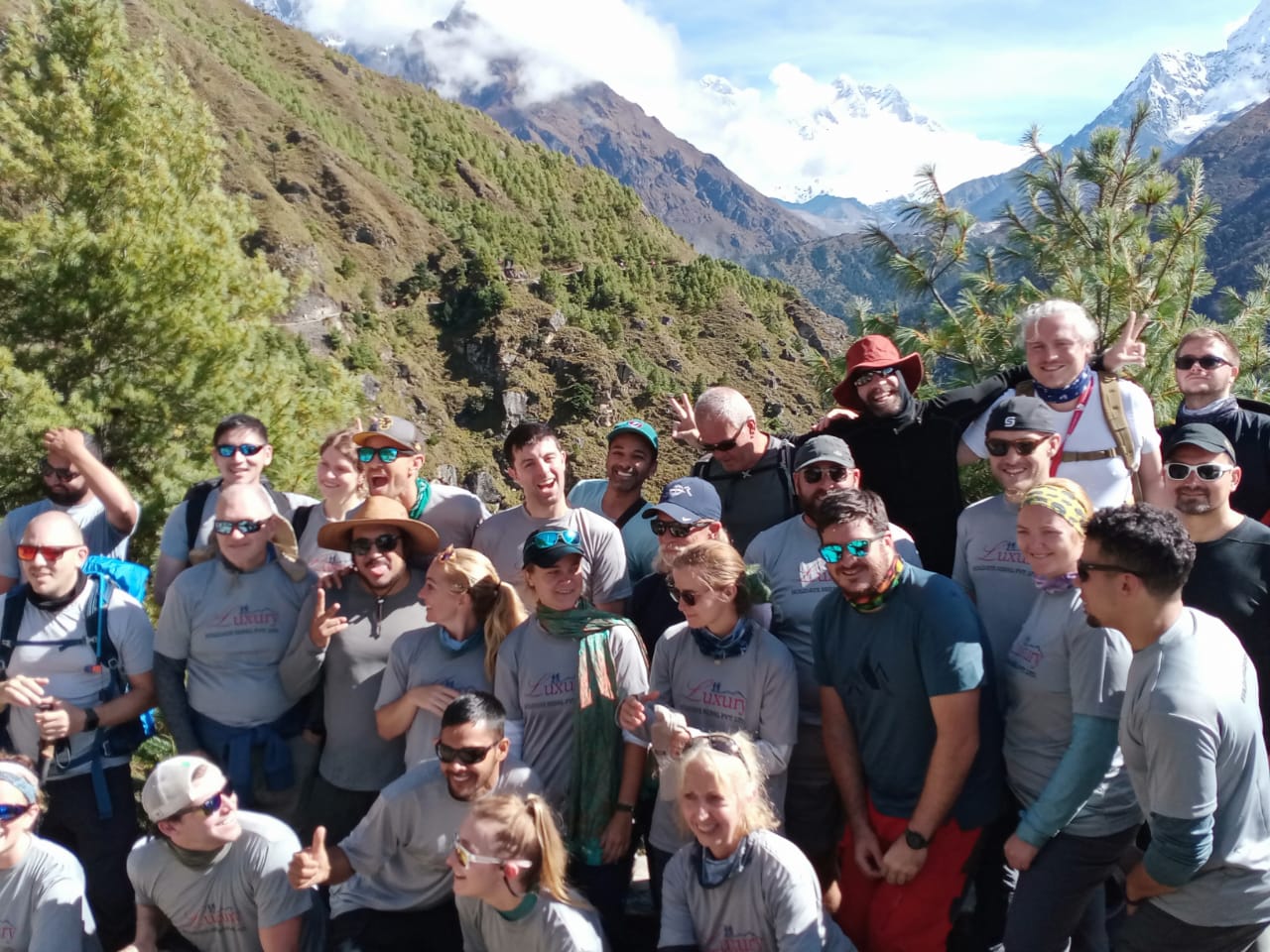
Among numerous trekking companies, Luxury Holidays Nepal stands out for its commitment to safety and customer satisfaction.
Here's why Luxury Holidays Nepal is your best choice:
- Experienced Guides: Luxury Holidays Nepal has a team of experienced and professional guides who are well-versed in the region's topography and potential challenges. They're trained in first aid and altitude sickness management, ensuring your safety throughout the journey.
- Itinerary Planning: The company offers carefully designed itineraries with adequate acclimatization days to minimize the risk of altitude sickness. The itineraries are also flexible to accommodate unforeseen circumstances like weather changes.
- Quality Accommodation: Luxury Holidays Nepal arranges for quality accommodation throughout the trek. They ensure that the lodges and teahouses you stay in maintain good hygiene practices and provide comfortable facilities, contributing to your overall well-being during the trek.
- Insurance: Luxury Holidays Nepal ensures that all their staff, including guides and porters, are insured. This reflects the company's commitment to the safety and well-being of not just its clients but also its employees.
- Pre-Trek Briefings: The company provides detailed pre-trek briefings, ensuring you're well-informed about the trek's demands, safety measures, and what to expect on the trail.
- Quality Equipment: Luxury Holidays Nepal ensures that you have access to quality trekking equipment, which plays a crucial role in your safety during the trek.
- Customer Reviews: The company has consistently received positive reviews from its customers, highlighting our reliability, attention to detail, and focus on safety.
Luxury Holidays Nepal's emphasis on safety, combined with their dedication to providing an unforgettable trekking experience, makes them a leading choice for trekkers planning their journey to Everest Base Camp. With them, you'll be in safe and experienced hands.
Luxury Everest Base Camp Trek
The Everest Base Camp Trek is an amazing journey that offers a unique opportunity to explore the heart of the Himalayas, witness breathtaking landscapes, and immerse yourself in the local Sherpa culture. Safety is a concern that is natural to have, especially considering the challenging terrain and high altitude. However, choosing a reputable trekking company like Luxury Holidays Nepal can significantly enhance your safety.
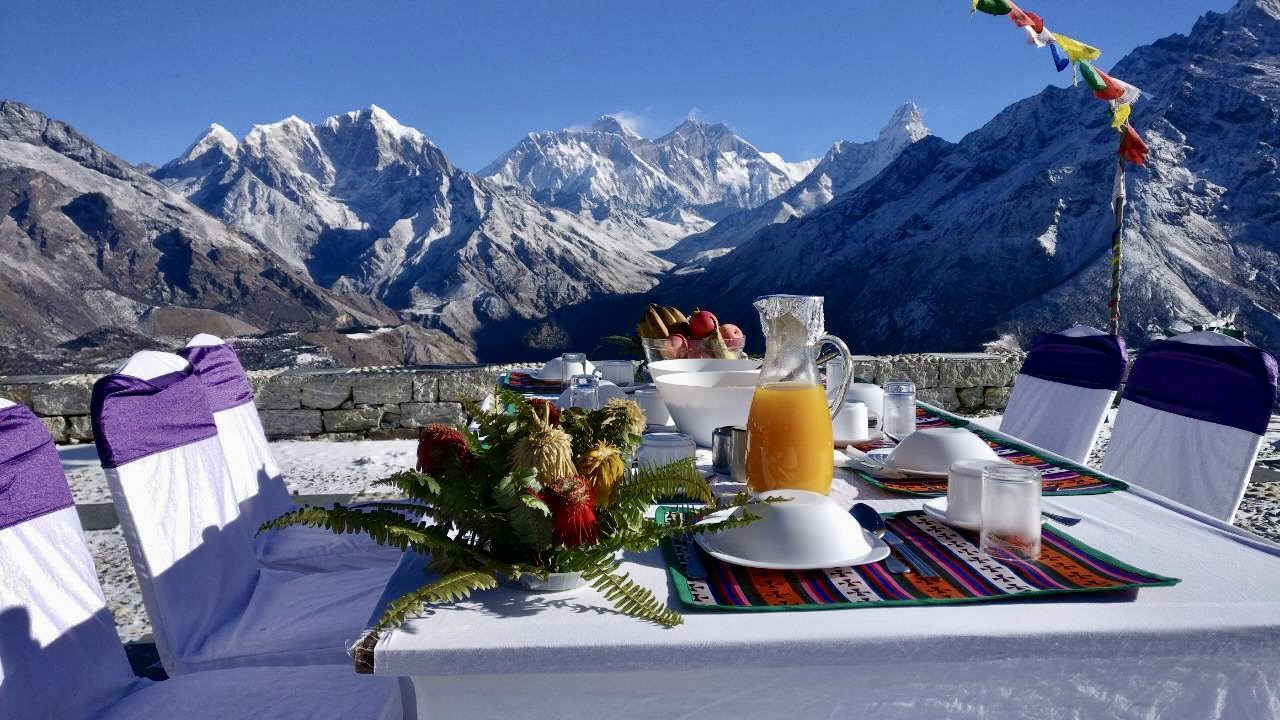
The Luxury Everest Base Camp Trek takes care of all safety-related aspects, from altitude sickness precautions to ensuring food hygiene. This trek is led by experienced and professional guides who are well-versed in mountain safety and first aid. They carry all necessary equipment, including a medical kit, oxygen cylinders, and a satellite phone to deal with any emergencies.
They also take care of all logistics, including accommodation and transportation, so you can focus on the trek and enjoy the stunning vistas. Accommodation throughout the trek is in luxury lodges and teahouses that provide comfortable and clean rooms and hygienic meals, which are important for maintaining your health on the trek.
Additionally, Luxury Holidays Nepal provides trekking insurance covering high-altitude trekking and emergency helicopter evacuation. This ensures that you are covered for any unexpected events that may happen during the trek.
In conclusion, while any high-altitude trekking adventure inherently has some risks, choosing Luxury Everest Base Camp Trek by Luxury Holidays Nepal can significantly enhance the safety and enjoyment of your journey. Their focus on safety, combined with their professional and experienced guides, means you can relax and enjoy the adventure of a lifetime.
Everest Base Camp Helicopter Trek
If you're looking for a less physically demanding and time-consuming way to experience the grandeur of Everest, the Everest Base Camp Helicopter Trek might be the perfect choice. It offers the unique experience of trekking in the Himalayas with the added convenience and safety of a helicopter ride.
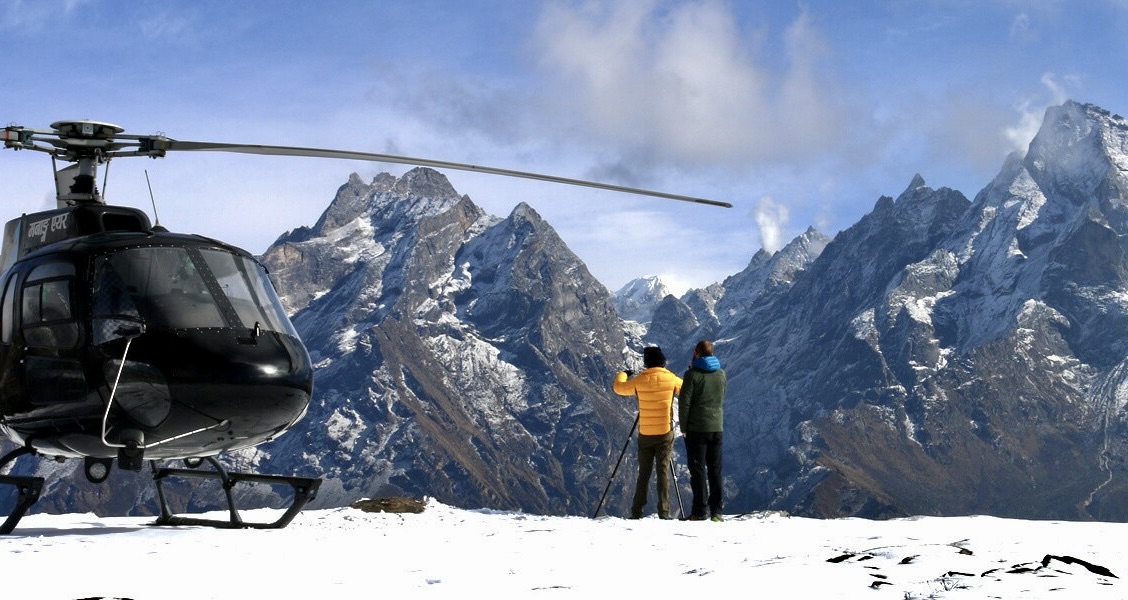
With the Everest Base Camp Helicopter Trek, you'll trek through the stunning landscapes of the Khumbu region, stay in local teahouses, interact with Sherpa communities, and enjoy the majestic views of the world's highest peaks. After reaching Everest Base Camp or Kalapatthar (depending on weather conditions), instead of retracing your steps, you'll be picked up by a helicopter. This offers breathtaking aerial views of the Everest region, which is an experience in itself.
The helicopter ride back provides an extra layer of safety. In the rare event of any altitude sickness or physical discomfort, the helicopter can fly you back to lower elevations quickly, reducing the risk associated with long descents on foot. Also, the helicopter ride cuts the length of the trek in half, reducing the physical demand and risk of injury.
Additionally, like all reputable trekking companies, safety measures like experienced guides, altitude sickness precautions, and adequate food and lodging arrangements are all in place.
Everest Base Camp Helicopter Trek offers an excellent balance of adventure and safety. While trekking does have inherent risks, these can be significantly mitigated by choosing such reliable and well-planned trekking options.
Trekking to Everest Base Camp is a dream for many adventurers around the world. While the journey is thrilling and packed with once-in-a-lifetime views, it comes with its share of challenges. Therefore, it's crucial to consider the safety aspects when planning your trek.
Preparation is key to a safe trekking experience. This includes adequate physical preparation, gathering the right gear, and understanding the risks associated with high-altitude trekking. Altitude sickness is a common concern, but with the right acclimatization schedule and prompt response to symptoms, it can be managed effectively.
The role of an experienced guide cannot be emphasized enough. Guides not only lead the way but are also trained to deal with emergencies, including first aid and altitude sickness management. Choosing a reputable trekking company, like Luxury Holidays Nepal, can significantly enhance your safety on the trail.
Ensuring your travel insurance covers high-altitude trekking is another vital step. This offers a safety net in case of unforeseen incidents or health issues during the trek.
Frequently Asked Questions: Safety for the Everest Base Camp
Q: What are the main risks associated with trekking to Everest Base Camp?
A: The main risks associated with the Everest Base Camp trek include altitude sickness, cold and harsh weather conditions, and physical injuries due to the rough terrain.
How can I prevent altitude sickness during the trek?
A: Preventing altitude sickness involves following a sensible acclimatization itinerary, staying hydrated, eating a balanced diet, and avoiding alcohol. It's also important to listen to your body and descend if you experience severe symptoms.
Q: How experienced should my guide be for the Everest Base Camp trek?
A: Ideally, your guide should have extensive experience trekking in the Everest region, be well-trained in first aid and emergency procedures, and have a deep understanding of high-altitude sickness.
Q: Is travel insurance necessary for the Everest Base Camp trek?
A: Yes, having comprehensive travel insurance is crucial for any high-altitude trek, including the Everest Base Camp trek. Ensure your policy covers evacuation and medical treatment in case of emergencies.
Q: Can I do the Everest Base Camp trek solo?
A: While it's possible to do the trek solo, it's not advisable due to safety reasons. Having a professional guide can be invaluable in case of emergencies and for navigating the challenging terrains of the Everest region.
Q: What kind of gear do I need for the trek?
A: You'll need sturdy, broken-in trekking boots, warm layers of clothing, a good quality down jacket, gloves, a hat, sunglasses, and sunscreen. Other essentials include a water purifier, a first aid kit, and hiking poles.
Q: When is the best time to do the Everest Base Camp trek?
A: The best times to do the Everest Base Camp trek are pre-monsoon (February to May) and post-monsoon (September to November) when the weather is generally stable and visibility is good.
Q: Is it safe for women to trek to Everest Base Camp?
A: Yes, it's safe for women to trek to Everest Base Camp, especially if you are trekking with a reliable company, an experienced guide, or in a group. It's always a good idea to research and follow advice on cultural customs to ensure respectful interactions.
Everest Region Trekking Packages
Everest Heli Trek with Kalapathher Landing
Gokyo Lakes and Everest Base Camp Trek
Everest Base Camp Heli Trek - 9 Days
VVIP Everest Base Camp Luxury Trek
Everest Base Camp and Gokyo Lakes Luxury Helicopter Trek
Luxury Everest Base Camp Trek - 14 Days
If you need any further information, please contact us by email: at [email protected], Phone: at +977- 985 100 5129 (WhatsApp)




